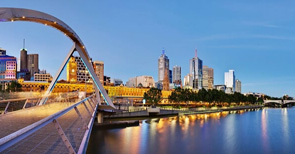-

Polish prestige project
The new Philharmonic Hall, completed in 2015, has added a clear architectural accent to the Szczecin cityscape, with MC as one of the contributors to its construction.
The new Philharmonic in Szczecin
Szczecin - Poland
The university city of Szczecin boasts 410,000 inhabitants and is the seventh largest metropolis in Poland. The old Hanseatic town lies on the Oder in the north-west not far from the German border and is a growing centre of commerce. Its landmarks from the past include Ducal Castle and the Cathedral Basilica of St. James. Now the new Philharmonic Hall, completed in 2015, has added a clear architectural accent to the Szczecin cityscape, with MC as one of the contributors to its construction.
The planning for the new concert hall for the renowned Szczecin Philharmonic began back in 2004. Since the 1950s, the orchestra had been playing in the City Hall auditorium. Its new home was to be built on precisely the site that the old concert house had occupied since 1884 until it was bombed in the Second World War and then torn down in the 1960s. Under the guidance of architects Fabrizio Barozzi and Alberto Veiga of Barcelona, a glistening icon of constructional art has now been erected in Poland’s western-most metropolis. It was festively inaugurated at the turn of 2014/2015, since which time it has received a number of accolades, including the coveted Mies van der Rohe Award in May 2015.
Long travel distances to the site
Work on the five-storey building with its two concert auditoria offering capacities of 953 and 192 began in April 2011. The city of Szczecin commissioned construction contractor Warbud with the project, and Warbud in turn placed the concrete supply order with the Szczecin ready-mix works of Thomas Beton Polska. As a trusted partner offering essential technological know-how in relation to concrete and admixtures, MC was also included as part of the team. Because the ready-mix works was located at the edge of the city and – particularly during rush hour periods – the delivery times could extend to a whole hour, transportation of the concrete represented a challenge.
The concrete technologists of Thomas Beton and MC therefore decided on formulations offering long-lasting consistency: for lower concrete class-es up to C20/25, they put their faith in the flow agent Muraplast FK 44, and for C25/30 and C30/37 concretes, in MC-Power Flow 2237, a high-performance superplasticiser based on advanced MC polymer technology. These concrete formulations were used for the foundations, walls, stairways and columns, for the building’s supports and for its underground car park.

© MC-Bauchemie 2016
Smoothing the way to success with the right plasticisers
Muraplast FK 44 exerts a strong liquefying effect even with small admixture quantities, helping to better wet and solubilise the cement. MC-Power Flow 2237 quickly and homogeneously mixes into the concrete, developing a long-lasting easy-flow effect. Its special combination of active ingredients enables stable concrete with high cohesion to be produced over the entire consistency range. During the winter period, the hardening acceler-ator Centrament Rapid 610 was also added, while in summer months the decelerator Centrament Retard 350 was used in order to compensate for the influences of temperature on the concrete. As a result, Thomas Beton and MC were able to satisfy all the contractor’s and client’s specifications, thus making a major contribution to the success of this extraordinary structure.
-
Name
The new Philharmonic in Szczecin
-
Country
Szczecin - Poland, 2016
-
Categories
-
Products
Muraplast FK 44
MC-PowerFlow 2236
Centrament Retard 350
Centrament Rapid 500
-
News
Click here to go to our News section.
-
MC-Pedia
In our MC-Pedia you will find technical articles on various topics written exclusively by our specialists.
-
Magazine
Get our latest issues of our customer and employee magazine MC aktiv.
-
Downloads
Find all relevant datasheets of our products as well as brochures of our company, Fields of Expertise and product categories here.
-
References
Click here to get to our library with reference projects for all types of application.
-
Careers
Click here to go to MC Career.
-
Contact
Click here to go to our Contact section.
